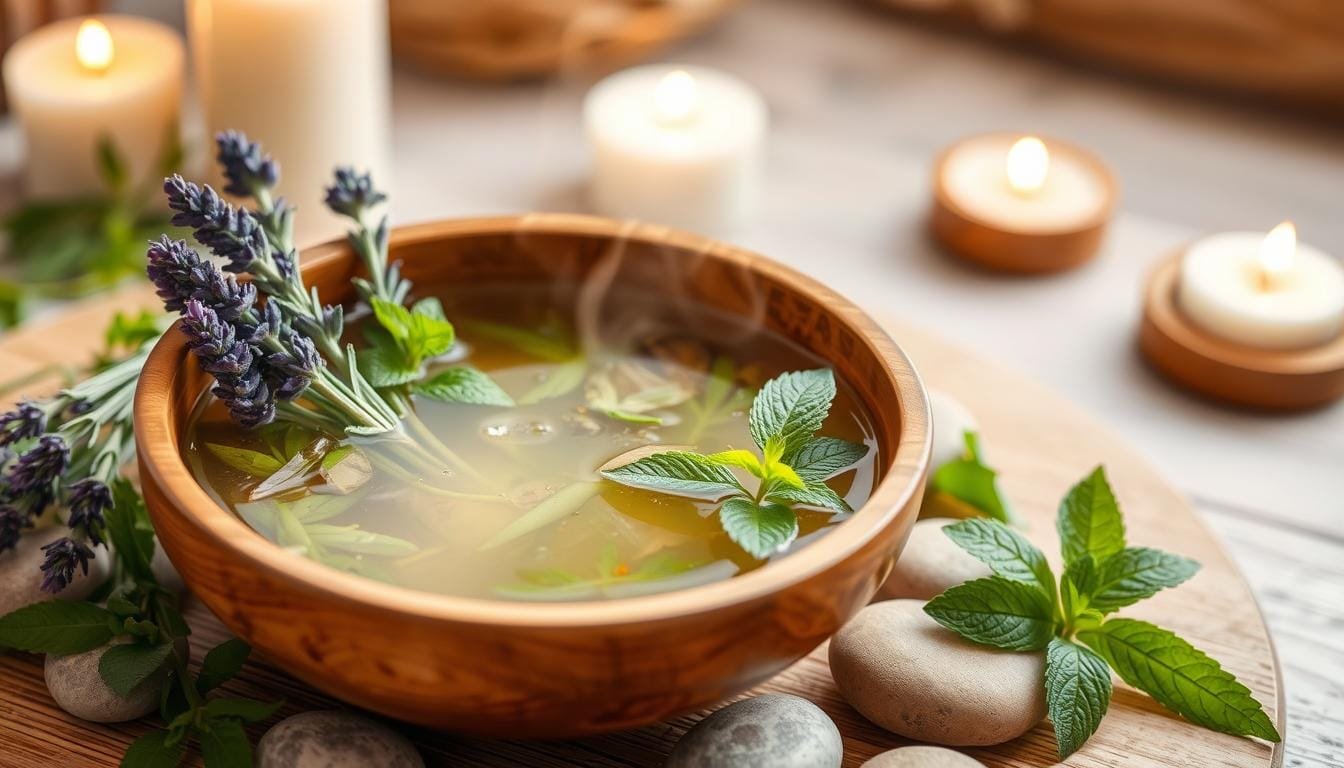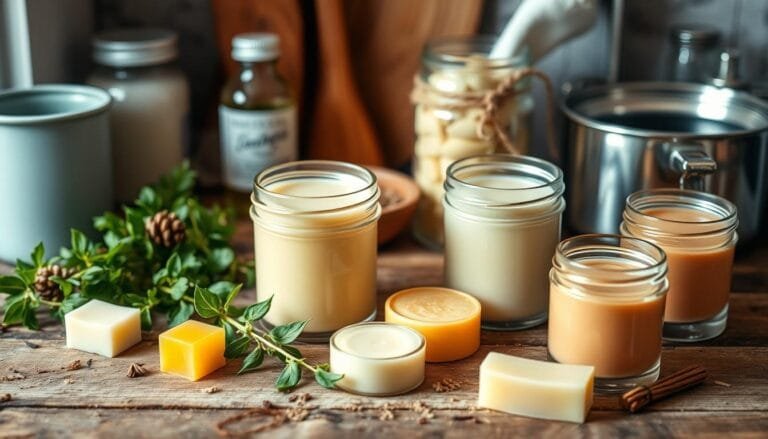As a busy professional, I’ve found that homemade herbal foot soaks are a game-changer. They’re easy and cheap to make, yet they offer a lot of benefits. These soaks can ease sore muscles, moisturize dry skin, and help you relax.
In this article, I’ll share different recipes and techniques for making your own herbal foot soak. You’ll learn how to create the perfect soak at home.
Enjoying a homemade herbal foot soak is a great way to take care of yourself. It combines natural herbs, essential oils, and other ingredients for a spa-like experience. They’re perfect for tired feet or just to find some peace.
Understanding the Benefits of Herbal Foot Soaks
Herbal foot soaks are more than a relaxing activity. They offer many physical and mental benefits. These soaks can ease tension, reduce swelling, and boost blood flow.
Physical Benefits
Herbs and essential oils in foot soaks tackle various physical issues. Epsom salt, for example, is great for easing muscle and joint pain. It works by releasing magnesium into the body through the skin, helping to relax and reduce swelling.
Vinegar is another key ingredient that fights fungal infections and softens dry skin. Soaking your feet in vinegar once a week can keep them healthy and smooth.
Mental Benefits
Herbal foot soaks also benefit your mind and emotions. Soaking your feet can calm you down and reduce stress. The scents of essential oils add to this calming effect, making you feel refreshed and renewed.
Therapeutic Properties
Herbal foot soaks can meet different therapeutic needs. Lavender, for instance, helps with stress and relaxation. Peppermint offers a cool and refreshing feeling. By choosing the right ingredients, you can target specific benefits like better sleep, mood, or muscle relief.
Adding herbal foot soaks to your self-care routine can change your life. They offer both physical and mental benefits, helping you relax and recharge.
Essential Supplies and Equipment for Your Foot Soak
To enjoy a relaxing foot soak at home, you need a few basic items. First, find a tub or large basin big enough for your feet. It’s also important to have towels ready – one for under the tub and another for drying.
Warm water is the key for a good foot soak. You can also add Epsom salt, essential oils, and herbs for extra benefits. A pumice stone or exfoliating brush helps with foot care after the soak.
| Item | Purpose |
|---|---|
| Tub or Basin | To soak feet in |
| Towels | For placing under the tub and drying off |
| Warm Water | The base for the foot soak |
| Epsom Salt | Adds minerals and reduces swelling |
| Essential Oils | Provides therapeutic benefits and aroma |
| Fresh or Dried Herbs | Enhances the soak with natural properties |
| Pumice Stone/Exfoliating Brush | For post-soak foot care and smoothing |
With these simple items, you can make your home feel like a spa. Use foot soak supplies and DIY spa equipment to make your at-home foot bath special.
Best Herbs and Botanicals for Homemade Herbal Foot Soaks
Choosing the right ingredients is key for a perfect homemade herbal foot soak. Certain herbs and botanicals offer unique benefits. They can make your self-care routine more rejuvenating. Let’s look at some of the best options for your botanical foot bath.
Fresh Herbs Options
Fresh herbs like peppermint, lavender, rosemary, chamomile, and lemon balm add a powerful aroma to your foot soak. They not only smell great but also have therapeutic properties. These can soothe and revitalize your feet.
Dried Herbs Choices
Dried herbs are great for a longer-lasting foot soak. Popular options include calendula, plantain, comfrey, and epsom salts. These herbs can help with various foot issues, like inflammation and tough skin.
Flower Petals and Blends
Adding rose petals or calendula petals can make your foot soak luxurious. Blending different herbs and botanicals can create custom combinations. This way, you can tailor your foot soak to your specific needs.
By choosing the right herbal foot soak ingredients, you can enjoy many natural foot care benefits. Create a luxurious botanical foot bath experience. Try different herbal foot soak ingredients to find the perfect mix for your self-care routine.
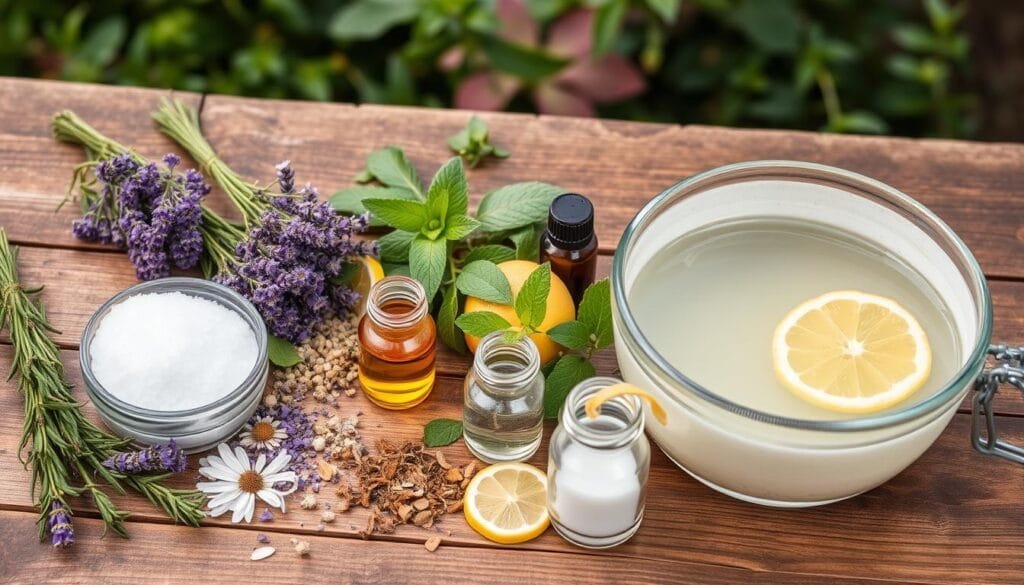
| Herb or Botanical | Benefits |
|---|---|
| Peppermint | Cooling, invigorating, and refreshing |
| Lavender | Calming, soothing, and promotes relaxation |
| Rosemary | Stimulating, improves circulation, and reduces inflammation |
| Chamomile | Anti-inflammatory, gentle, and promotes skin healing |
| Lemon Balm | Uplifting, refreshing, and promotes stress relief |
The Role of Essential Oils in Foot Soaks
Essential oils can change your foot soak game. These plant extracts smell amazing and offer many health benefits. They can make your foot care routine better.
Essential oils work well in foot soaks because they absorb easily through the feet. The skin on your feet is less sensitive, perfect for oils. The large pores on your feet also help oils get absorbed quickly, bringing their benefits to your body.
When picking essential oils for your foot soak, think about what you want to achieve. Peppermint oil can ease muscle pain, lavender oil helps you relax, and tea tree oil fights fungus. Start with 5-20 drops of oil per soak, adjusting as needed.
| Essential Oil | Benefits | Suggested Drops per Foot Soak |
|---|---|---|
| Peppermint | Soothes sore muscles | 8-12 drops |
| Lavender | Promotes relaxation | 6-10 drops |
| Tea Tree | Offers antifungal properties | 5-8 drops |
Always mix essential oils with a carrier oil like jojoba or coconut oil. This prevents skin irritation and spreads the oils evenly in the water.
“The feet have thousands of nerve endings that correspond to different organs and body parts, making them a prime target for essential oil application.”
Using the right essential oils for feet in your soak can be a holistic and therapeutic experience. Try different oil mixes to find the best one for your feet. This will leave them feeling refreshed and ready for the day.
Creating the Perfect Relaxation Environment
Making your home a spa is essential for enjoying your herbal foot soak. The right mood and setting help you relax deeply. You’ll feel refreshed and renewed.
Setting the Mood
Dim the lights, light candles, and play calming music. This creates a peaceful space. It’s like stepping into a serene oasis, away from daily worries.
Let your senses enjoy the spa atmosphere. Use relaxation techniques to enhance the foot soak ambiance.
Temperature Considerations
The water temperature is key for comfort. Keep it between 92-100°F (33-37.7°C). This warmth is perfect for relaxation and healing.
Timing Your Soak
Set aside 15-60 minutes for your soak. This time lets you fully relax and enjoy the herbs’ benefits. Don’t rush; take your time to unwind completely.
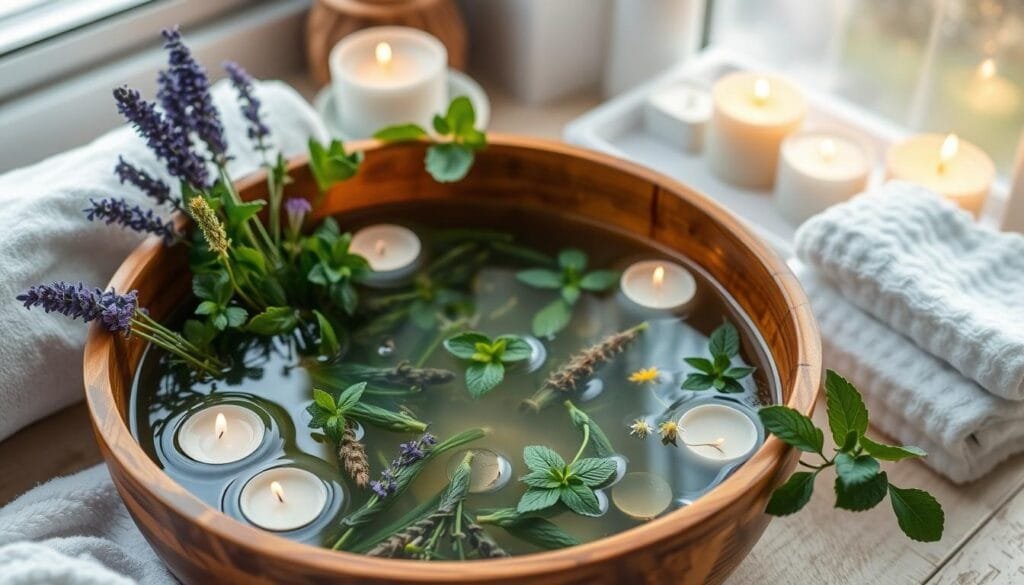
Creating the right environment makes your herbal foot soak special. It’s a chance to practice self-care and enjoy the calming atmosphere.
Basic Herbal Foot Soak Recipe for Beginners
If you’re new to DIY herbal foot soaks, this simple recipe is great for you. It only needs a few basic ingredients. You can make a foot soak that feels relaxing and rejuvenating.
To make this simple foot soak recipe, you’ll need:
- 1/2 cup of Epsom salt
- 1/4 cup of dried herbs (such as lavender or chamomile)
- 3-6 drops of your favorite essential oil (optional)
Mix the Epsom salt and dried herbs in a large bowl. If you want to add essential oils, mix in 3-6 drops. Then, pour the mix into a warm foot basin filled with water.
Sit back, relax, and soak your feet for 15-20 minutes. This DIY herbal bath can be tailored to your liking. It’s a beginner-friendly foot care routine you can enjoy anytime.
“Adding a few drops of essential oils to your foot soak can help you unwind and destress after a long day.”
Remember, the key to a perfect foot soak is to listen to your body. Try different herb and oil combinations to find your favorite. Enjoy making your own DIY herbal bath and the beginner-friendly foot care it offers.
Therapeutic Combinations for Different Needs
Creating custom herbal foot soaks can change your foot care game. Whether you need to ease sore muscles, moisturize dry skin, or reduce stress, the right mix can help. The right foot soak recipes can make a big difference.
For Sore Muscles
For aching feet, try a soak with Epsom salt, peppermint, and rosemary. Epsom salt cuts down inflammation and eases muscle tightness. Peppermint and rosemary essential oils add a refreshing touch. This soak is great for after workouts or long days on your feet.
For Dry Skin
For dry, cracked heels and calluses, use a soak with honey, coconut milk, and oatmeal. Honey and coconut milk moisturize and soften your skin. Oatmeal gently exfoliates, leaving your feet smooth. This soak is perfect for dry, dehydrated skin.
For Stress Relief
For a calming soak, mix lavender, chamomile, and geranium essential oils. These oils calm your mind, reduce stress, and boost well-being. This soak is ideal for unwinding after a stressful day.
By making targeted foot soaks for your needs, you can enjoy homemade herbal baths. Try different blends to find the best for your concerns. This way, you get a top-notch foot care experience.
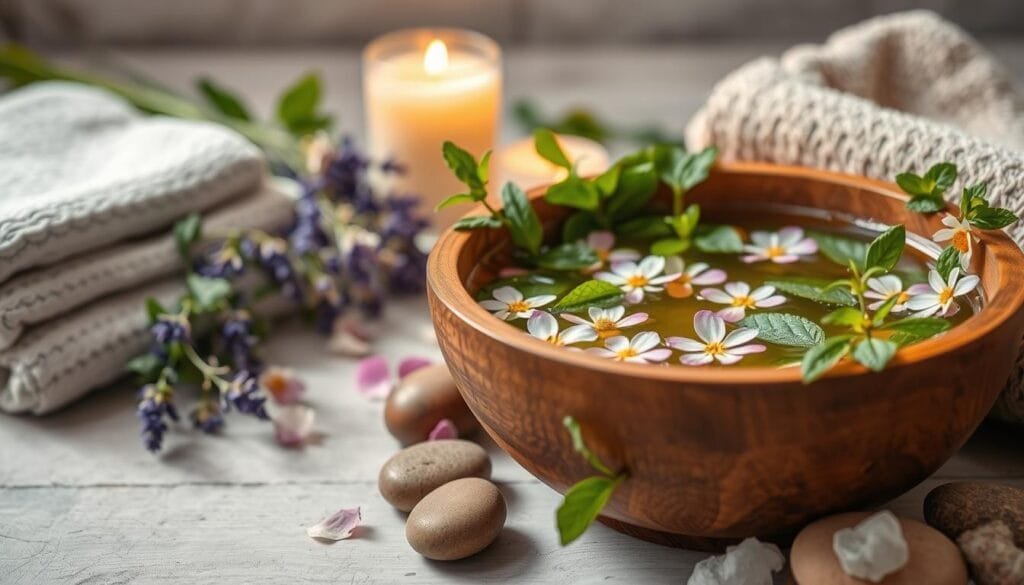
Natural Additives to Enhance Your Foot Soak
Adding natural additives to your foot soak can make it even better. Baking soda helps exfoliate gently, while apple cider vinegar softens the skin. These ingredients turn your DIY spa into a luxurious treat.
Epsom salt is a great addition to foot soaks. It’s full of magnesium, which relaxes muscles and eases pain. Magnesium is key for many bodily functions, like heart health and muscle relaxation.
Colloidal oatmeal is also excellent. It soothes dry or irritated skin. Oatmeal’s antioxidants and anti-inflammatory properties are perfect for sensitive skin.
| Foot Soak Enhancer | Benefits | Recipes |
|---|---|---|
| Baking Soda | Gentle exfoliation, odor control | 1/4 cup baking soda, 1-2 teaspoons of dried sage, 5 drops of Rosemary Essential Oil |
| Apple Cider Vinegar | Skin softening, antimicrobial properties | Recipe for cracked feet: 1 cup Listerine and 1 cup vinegar |
| Epsom Salt | Muscle relaxation, magnesium absorption | 1/2 cup Epsom Salt, 5 drops of Peppermint Essential Oil, 1 drop Eucalyptus Essential Oil |
| Colloidal Oatmeal | Soothing, anti-inflammatory | Recipe for sensitive skin: 1/2 cup Epsom Salt, 5 drops of Eau de Provence Bath and Body Oil |
Try mixing different foot soak enhancers, natural bath additives, and DIY spa ingredients. This way, you can create a soak that meets your needs. Whether you want to ease muscle pain, soften skin, or just relax, these natural ingredients can make your homemade soak even more special.
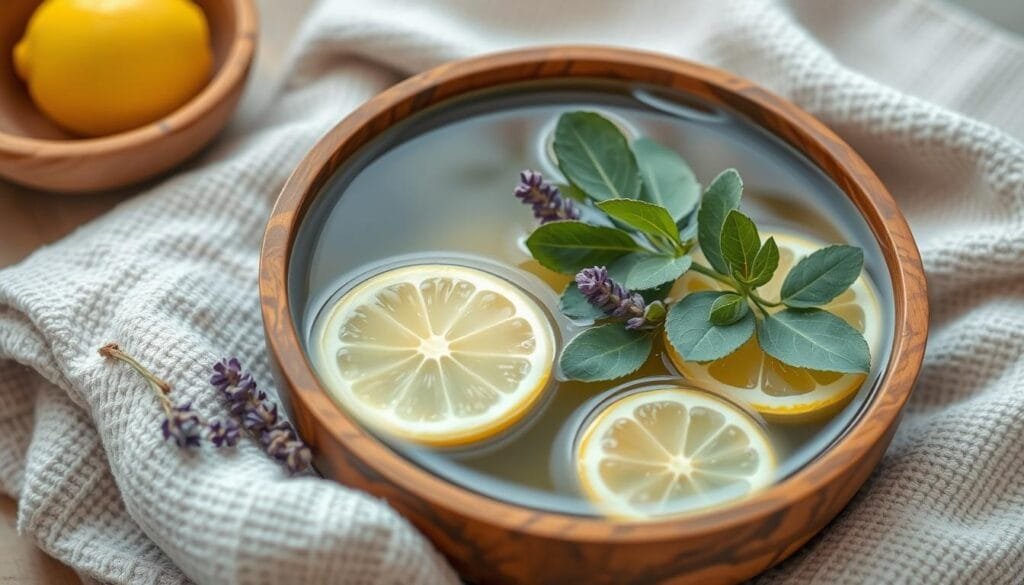
Safety Considerations and Precautions
Before you try an herbal foot soak, think about a few safety tips. Keeping the water at the right temperature and watching out for allergies or sensitivities is key. This way, you can enjoy a relaxing and refreshing soak.
Temperature Guidelines
Always check the water temperature before you put your feet in. The water should be warm, between 95°F and 105°F (35°C to 41°C). Don’t use water that’s too hot, as it can hurt your skin. Water that’s too hot can also make you dizzy or nauseous.
Allergies and Sensitivities
Be careful if you have allergies or sensitivities to the herbs or essential oils in your soak. Do a patch test on your skin before soaking. If you have skin conditions or open wounds, talk to a doctor first.
Duration Recommendations
Soak your feet for 15-60 minutes to avoid dryness or irritation. Soaking for too long can dry out your skin or cause infections, which is bad for sensitive skin. If you’re worried, ask a doctor about the right soak time for you.
By following these safety tips and thinking about your skin, you can enjoy the relaxing benefits of an herbal foot soak. You’ll avoid any bad side effects.
“Prioritize your foot soak safety by considering temperature, allergies, and duration – a little precaution goes a long way in ensuring a truly enjoyable and rejuvenating experience.”
Post-Soak Care and Moisturizing Tips
After a refreshing herbal foot soak, it’s key to take good care of your feet. Start by gently patting them dry with a soft towel. This step prevents moisture from causing irritation or bacterial growth.
Then, apply a nourishing moisturizer or foot oil to your clean feet. Choose products with shea butter, coconut oil, or glycerin for deep hydration. Massaging the moisturizer in can also boost circulation and relax muscles.
- Use a pumice stone or foot file to remove dead skin while your feet are soft from the soak.
- For extra hydration, wear soft cotton socks after applying a thick foot butter or ointment.
- Elevate your feet for 20 minutes after soaking to improve circulation and reduce swelling.
By following these foot care routine and moisturizing techniques after your spa aftercare, you’ll get the most from your homemade herbal foot soak. Your feet will stay happy and healthy.
| Ingredient | Ratio | Benefits |
|---|---|---|
| Listerine | 1 cup | Antifungal, antiseptic properties for cracked feet |
| Vinegar | 1 cup | Helps soften and exfoliate callused feet |
| Sea Salt | 1/4 cup | Reduces inflammation and draws out impurities |
| Tea Tree Essential Oil | 2 drops | Antibacterial, antifungal properties for callused feet |
“Caring for your feet after a soothing foot soak is just as important as the soak itself. Take the time to properly moisturize and pamper your tootsies for long-lasting softness and rejuvenation.”
Storage and Shelf Life of Herbal Mixtures
Keeping your homemade herbal foot soak blends fresh and potent is key. There are important things to remember about storage and shelf life.
Dry herbal blends should be stored in airtight containers, away from light and moisture. They can last up to 6 months this way. But, blends with essential or carrier oils should be refrigerated and used within 2-4 weeks.
Before storing, label each container with ingredients and the date made. This helps you know when to use it. If you see mold or a bad smell, it’s time to throw it away.
| Ingredient | Shelf Life |
|---|---|
| Aloe Vera Inner Leaf Gel | 2 years |
| Aritha Powder (Soapnut) | 2 years |
| Copaiba Balsam | 4 years |
| Lavender, Sandalwood, Peppermint Essential Oils | 5 years |
| Liquid Castile Soap | 3 years |
By following these tips, your homemade herbal blend storage, DIY foot soak preservation, and homemade spa products will stay fresh. They’ll be ready to give you the best relaxation experience.
Seasonal Foot Soak Recipes and Adaptations
As the seasons change, so should our homemade herbal foot soaks. We can make our foot care routines more refreshing and therapeutic. In summer, I enjoy a cool mix of mint and lemongrass. These herbs soothe tired, swollen feet after a day in the sun.
In winter, I choose a warm foot soak recipe. Ginger, cinnamon, and clove create a cozy, spicy scent. These herbs warm me up and help with muscle aches from cold weather activities.
I also make special holiday foot soaks to enhance my self-care. Pumpkin spice is great for fall, and peppermint is festive in winter. Changing the water temperature and herbs with the seasons keeps my soaks effective and enjoyable.
